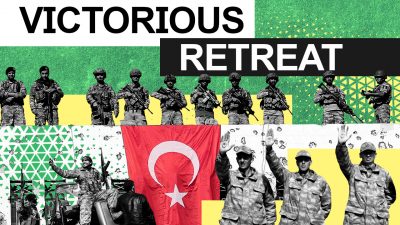Video: Syrian Army Win Battle Against Erdogan Forces in Idlib, but War Is Far from Over

The first days of March broke the dreams of the Turkish political and military leadership of a swift victory over the Syrian Armed Forces. Operation Spring Shield failed to achieve the goal officially declared by top Turkish officials – to push the Syrian Army back from territories liberated in Idlib since September 2018, when Moscow and Ankara reached so-called Sochi agreements. The deal was intended to separate terrorists from moderate rebels, create a 30km deep demilitarized zone and de-escalate the situation in Greater Idlib in general. These agreements have never been fully implemented because Hayat Tahrir al-Sham and other al-Qaeda-linked groups did not withdraw from the demarked demilitarized zone and did not separate from these mysterious moderate rebels that reportedly existed somewhere in Idlib.
This led to the resumption of active anti-terrorist actions by the Syrian Army supported by Russia and Iran, the liberation of thousands of km2 from radicals, and the deployment of Syrian troops within striking distance of Idlib city. Ankara saw the existence of the militant-held enclave in Greater Idlib as an important tool of its policy towards Syria considered its possible destruction a vital threat to its own interests and responded with a large-scale military operation against the Damascus government.
Since its start, Turkish forces have victoriously captured Nayrab village and a few other nearby positions. At one point, they also entered the town of Saraqib on the M5 highway, but were then forced to retreat after they were counter-attacked by the Syrian Army. Later, units of the Russian Military Police deployed there.
The Nayrab success came amid major setbacks of the Turkish-led forces in southern Idlib. Syrian forces captured over a dozen settlements and repelled Turkish attempts to recapture the town of Kafr Nabul. The Turkish-led attack on positions of the Syrian Army in western Aleppo also ended with no results after the Syrian Army took back Sheikh Aqil and the nearby hilltop that it had lost to Turkish-led forces for a day.
Summing up, the Syrian Army defeated Turkish-led forces in an open battle, kept control over key positions along the M5 highway, and set conditions for further advances south of the M4 highway.
According to Syrian state media, in the period from December 15, 2019 to March 5, 2020 government forces liberated 215 settlements spread across 1,600km2. During the same period, 6,100 terrorists were eliminated, 2550 others were wounded, and 615 vehicles belonging to Turkish-backed militant groups were destroyed. The report also claimed that 100 ‘Turkish’ pieces of military equipment were eliminated. These numbers as well as those provided by the Turkish side about supposed Syrian Army casualties are highly overestimated. As of the evening of March 5, the Turkish Defense Ministry claimed that its forces had ‘neutralized’ 3,322 Syrian soldiers, shot down 3 warplanes, 8 helicopters, 3 UAVs, destroyed 155 battle tanks, 103 artillery pieces and rocket launchers, 8 air defense systems, 15 anti-tank weapons, 4 mortars, 157 various military vehicles and 10 weapon depots.
Turkey and Syria should make at least a bit softer claims if they want to make these claims look more reliable. Regardless of the provided numbers, the situation on the frontline speaks for itself. The March 5 visit of Turkish President Recep Erdogan to Moscow came amid another large-scale attack of Turkish-led forces on Saraqib. This attack, however, was repelled.
The Russian and Turkish presidents negotiated a new deal to de-escalate tensions in Idlib. It includes the following:
- The cessation of all hostilities along the existing line of contact from midnight on March 6th;
- Russia and Turkey will create a six-kilometer-deep security corridor both north and south of the M4 highway;
- Russia and Turkey agreed to begin joint patrols on March 15th along the M-4 highway in Syria;
- All previous agreements remain in effect. Terrorists are excluded from the ceasefire.
This agreement has several important implications:
- Turkey in fact confirmed that it had lost its small war on Syria and officially accepted all the gains made by the Syrian Army since September 2018;
- The Syrian Army kept control of the M5 highway and significantly improved its military position in the region;
- The agreed buffer zone, along the M4 highway, is located inside the militant-held area. It can only be created and joint patrols launched if radical militants are removed from this sector. If militants are not removed, this will create conditions for another operation in the area, fully within the framework of the agreement signed by Turkey;
- Both Turkey and Russia declared that they support a political solution to the conflict. However, a political solution is not possible as long as terrorist groups are present in the area. This creates conditions for further tensions and escalations.
*
Note to readers: please click the share buttons above or below. Forward this article to your email lists. Crosspost on your blog site, internet forums. etc.
Support South Front in its endeavors. If you’re able, and if you like our content and approach, please support the project. Our work wouldn’t be possible without your help: PayPal: [email protected] or via: http://southfront.org/donate/ or via: https://www.patreon.com/southfront

